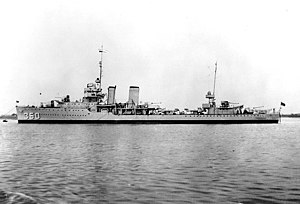USS Hull (DD-350)

USS Hull (DD-350)
|
|
| History | |
|---|---|
|
|
|
| Name: | Hull (DD-350) |
| Namesake: | Isaac Hull |
| Builder: | New York Navy Yard |
| Laid down: | 7 March 1933 |
| Launched: | 31 January 1934 |
| Commissioned: | 11 January 1935 |
| Fate: | Foundered in storm, 18 December 1944 |
| General characteristics | |
| Class and type: | Farragut-class destroyer |
| Displacement: | 1,395 tons |
| Length: | 341 ft 4 in (104.04 m) |
| Beam: | 34 ft 3 in (10.44 m) |
| Draft: | 8 ft 10 in (2.69 m) |
| Speed: | 36 knots (67 km/h) |
| Complement: | 160 officers and men |
| Armament: |
|
The third USS Hull (DD-350) was a Farragut-class destroyer in the United States Navy during World War II. She was named for Isaac Hull.
Hull was launched by New York Navy Yard 31 January 1934; sponsored by Miss Patricia Louise Platt; and commissioned 11 January 1935, Commander R. S. Wentworth in command.
Hull received 10 battle stars for World War II service, having sailed to Europe, and serving in the Pacific before and during the war in combat. After addition of equipment that made her more top-heavy, she was one of three destroyers sunk by heavy seas encountered in Halsey's Typhoon. 11 officers of the Hull, including the executive officer, and 191 enlisted sailors perished in the sea, while 7 officers and 55 enlisted men were recovered.
Following a shakedown cruise which took her to the Azores, Portugal, and the British Isles, Hull arrived San Diego, California, via the Panama Canal 19 October 1935. She began her operations with the Pacific Fleet off San Diego, engaging in tactical exercises and training. During the summer of 1936 she cruised to Alaska and in April 1937 took part in fleet exercises in Hawaiian waters. During this increasingly tense pre-war period, Hull often acted as plane guard to the Navy's Pacific aircraft carriers. She continued these operations until the outbreak of the war, moving to her new home port, Pearl Harbor, 12 October 1939.
...
Wikipedia
